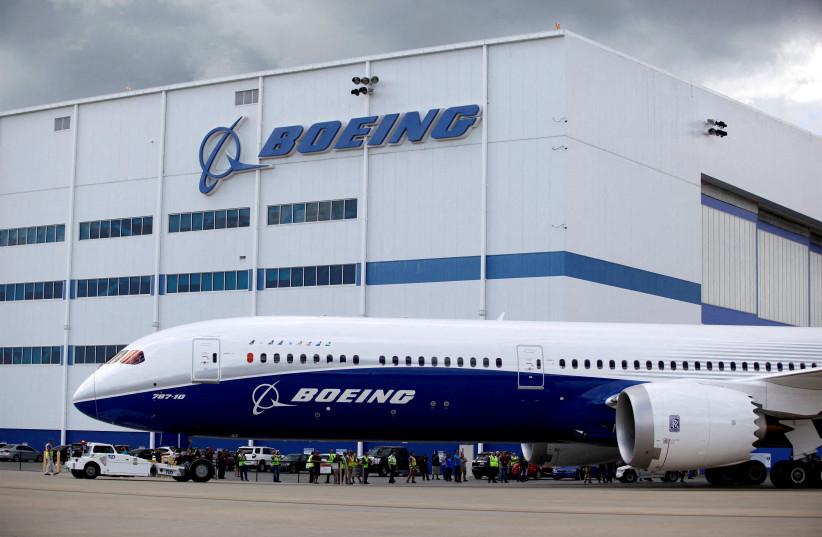Demand for international air travel in Israel is back to at least the same level as before the pandemic, and this trend is being seen across the world too, a senior Boeing executive said in a review of the current state of the global civil aviation industry during a visit to Tel Aviv last week.
Darren Hulst, vice-president, commercial marketing for the major US plane maker, presented to aviation reporters an optimistic outlook for Israel’s air travel industry, but with it come increased airfares as airlines stretch themselves to try to meet travelers’ wishes.
“There’s incredible demand that continues to be observed for air travel in the Israel market. Capacity is back to pre-pandemic levels already, if not slightly higher, [and] demand is driving fares up because of the shortage in capacity,” Hulst said.
“We are seeing revenue levels already above pre-pandemic levels in the first part of this year and that will continue to drive competition and the need for additional aircraft as we move through this year and into 2024,” he added.
Concerning the availability of Israeli-owned aircraft to ferry passengers, Hulst said that wide-body capacity (airliners used mainly on long-haul routes) is above pre-pandemic levels and that single-aisle jets on shorter-range routes are currently at precisely the level of availability as they were in 2019.

But in a broader and more telling perspective, since 2013, the number of seats on offer to meet demand to and from Tel Aviv have increased by 70%.
“We have seen significantly faster growth in [the Israeli] market than we have on a global basis, and it’s driven by both expansion in the wide-body, long-haul market and in the single-aisle, low-cost regional market,” Hulst said.
By 2030, International Air Travel Association (IATA) figures show a projected increase of some 30% in passenger traffic, the Boeing executive predicted.
Boeing Israel President Ido Nehushtan said that in view of those figures, almost 40 million passengers – about double the number currently using the airport – could be expected to pass through Ben-Gurion Airport at the end of the decade. Last year, 19.2 million passed through Israel’s only significant international air hub.
How have the Abraham Accords boosted air traffic to and from Israel?
Diplomatic developments following the signing of the Abraham Accords have also been a contributing factor to the increase in air traffic to and from Israel, Hulst said.
“We can see over the last few years how those agreements have helped expand networks in the North Africa and Middle East region. In the last three years we have seen five new destinations from Tel Aviv to Morocco and the Gulf [Marrakesh, Casablanca, Dubai, Bahrain and Abu Dhabi] and if you think of the success of these markets, you just have to watch how carriers are behaving: Emirates [airline] are already adding more flights to Dubai and total capacity in the past year in these markets is up by 50%,” he said.
This, and the opening of the airspace of Saudi Arabia and Oman for long haul flights to the Asia-Pacific region are having a significant impact in growing Israel’s aviation market, he said.
And even if Israel is not a major player in global aviation, it serves as a good indicator of international trends that point to a vast increase in demand for new passenger aircraft of all kinds that are going to be needed in the next two decades.
Before the pandemic, the total size of the global commercial fleet was just under 26,000 jets, Hulst said. A small number of those aircraft will still be in service in 20 years’ time but the vast majority – 80-85% percent – will be replaced by more efficient and more cost-effective planes alongside another 20,000 units that will have to be added as the market grows.
Although pressed, Hulst declined to discuss how El Al might react as it continues with its plans to grow its business and in replacing some of its older aircraft in the coming years, or whether it might opt to break with long-standing tradition and go for a deal with Boeing’s main commercial rival, Eurpean plane maker Airbus. Negotiations in multi-billion-dollar deals often comtain a tactical element as airlines seek to reduce unit costs and hasten delivery times.
Senior El Al executive Sharon Brownstone told The Jerusalem Post Annual Conference in New York last week that the airline was looking to increase passenger numbers and that it is planning to replace some of its single-aisle 737s with larger 787s, a way to accommodate added demand.
“Our goal is to reach 7.5 million passengers in a year,” she said.
Market analysts also see a need for Israel’s flag carrier to replace its aging 777-200s, the largest and some of the oldest planes in its fleet, with Boeing’s newest variants from the 777-X family. These can accommodate over 400 passengers for long- and extra-long haul routes in new and traditional markets, although their arrival is likely to take several years.
“We’ve had 75 years of partnership with El Al through good times and through challenging times, and I think we are looking forward to being partners going forward,” Hulst concluded.
